Viking weddings, also known as Norse weddings, have become increasingly popular in recent years due to their unique and rich cultural traditions.
Back in the day, these weddings were not only a celebration of love between two individuals, but also a celebration of the joining of two families. Viking weddings were known for their grandeur and festivities, which often lasted for a week.
One of the most intriguing aspects of Viking weddings was the exchange of swords between the bride and groom. This tradition symbolized the transfer of protection from the bride’s father to her new husband.
And much like today, Viking weddings also included the exchange of rings, which were often adorned with intricate designs and symbols.
So if you’re planning a modern Viking wedding, there are many ways to incorporate these ancient traditions into your special day. From incorporating Viking horns into your decor to wearing traditional Viking attire, there are endless possibilities to make your wedding unique and unforgettable.
With the right planning and attention to detail, you can create a wedding that pays tribute to the rich history and culture of the Vikings.
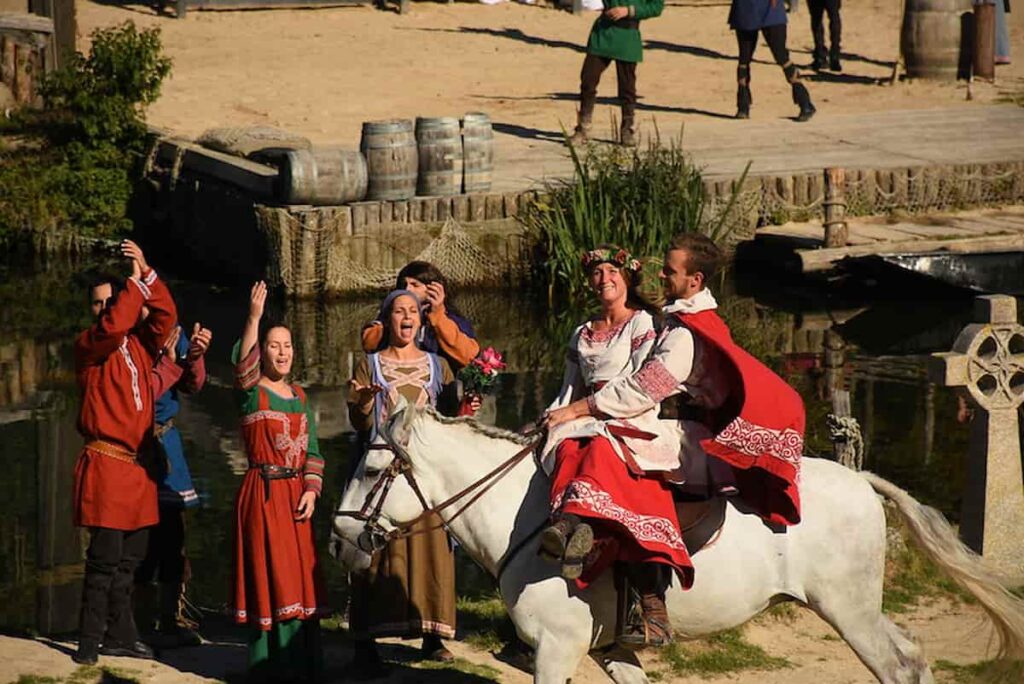
Table of Contents
Viking Wedding Traditions
Exchanging Swords
One of the most iconic Viking wedding traditions is the exchanging of swords. The bride and groom would exchange swords as a symbol of their commitment to protect each other and their family.
This tradition was also seen as a way to unite the two families and create a bond between them.
Handfasting ritual
One of the most unique aspects of a Viking wedding was the handfasting ritual. During the ceremony, the bride and groom’s hands were tied together with ribbons or cords while they said their vows.
This symbolized their union and their commitment to each other. And, in fact, the modern-day phrase “tying the knot” comes from this Viking wedding ritual.
Wedding Feast
The Viking wedding feast was an important part of the celebration. It was a time for the families to come together and celebrate the union of the bride and groom.
The feast would typically include meat, mead, and other traditional Viking foods. The bride and groom would sit at the head of the table, and the guests would toast to their health and happiness.
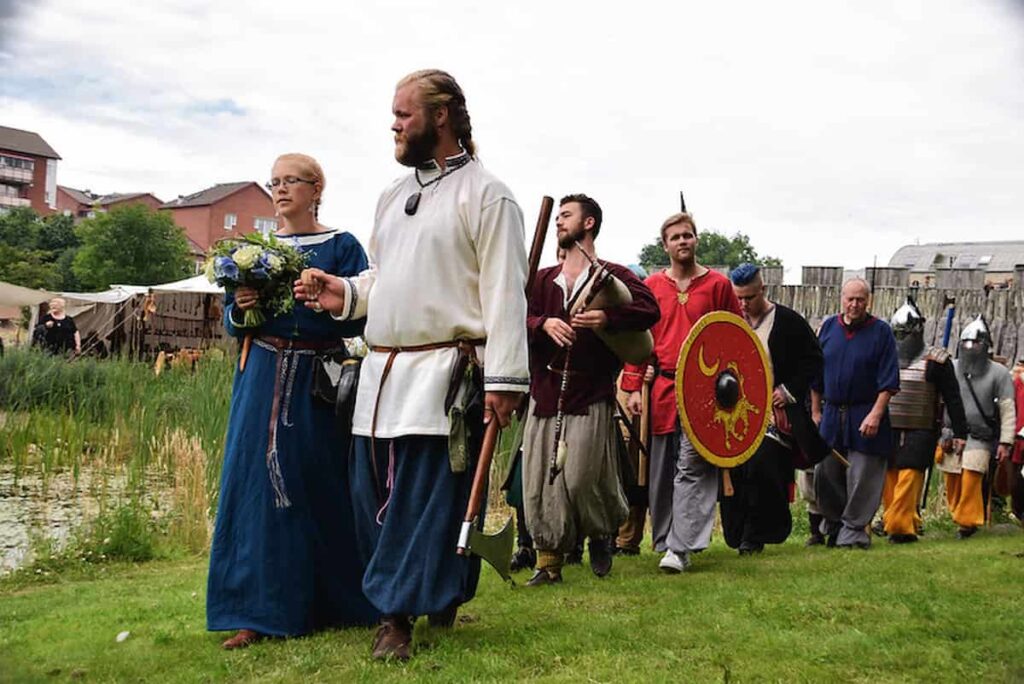
Wedding Clothing
The bride and groom would wear traditional Viking clothing for their wedding. The bride would wear a long dress, often made of linen or wool, and a headdress made of flowers or beads.
On the other hand, the groom would wear a tunic and trousers made of wool or linen, and a cloak made of animal fur.
Drinking Horns
Drinking horns were a common sight at Viking weddings. They were often used to serve mead, a traditional Viking drink made from fermented honey.
The bride and groom would drink from the same horn as a symbol of their union.
Wedding Hair
The bride’s hair was an important part of the wedding ceremony. Vikings often had braided hair, with the bride’s hair being adorned with flowers or beads.
The groom would also wear his hair in a traditional Viking style, often braided and tied back with a leather cord (although the query of whether Vikings had dreads is still a bit of a question mark, despite what pop culture would have you think).

Animal Sacrifice
Animal sacrifice was a common practice at Viking weddings. The sacrifice was seen as a way to honor the gods and ensure a happy and prosperous marriage.
The animal would be slaughtered and its blood would be sprinkled on the bride and groom as a symbol of their union.
Honeymoon
The Viking honeymoon was a time for the bride and groom to be alone and consummate their marriage. They would often retreat to a secluded location, such as a cabin in the woods or a tent on the beach, for several days.
Overall, Viking weddings were steeped in tradition and symbolism. Each tradition had a specific meaning and was meant to ensure a happy and prosperous marriage.
From the exchanging of swords to the wedding feast, every aspect of the wedding was carefully planned and executed.
How to Have a Modern Viking Wedding Ceremony
If you’re looking to have a Viking wedding ceremony that’s both traditional and modern, there are a few things to consider. Here are some ideas to help you plan a memorable and unique event:
- Choose an outdoor or rustic venue, such as a forest, beach, or barn. This will give your ceremony a natural and authentic feel.
- Consider incorporating Viking-inspired decorations, such as long wooden tables, candles, animal skins, and flowers. You can also use Viking symbols, such as the hammer of Thor or the Valknut, to add a touch of Norse mythology.
- Wear traditional Viking attire, such as a fur cloak, leather boots, and a horned helmet. Alternatively, you can opt for a modern twist on the Viking look, such as a simple white dress with braided hair and a floral crown.
- Include traditional Viking rituals, such as a handfasting ceremony, where you and your partner’s hands are bound together with a ribbon or cord to symbolize your union. You can also exchange Viking-inspired vows, such as “I swear by Odin and Thor to love and cherish you, to be your protector and provider, and to share in all of life’s adventures.”
- Consider having a Viking-style feast after the ceremony, complete with mead, roasted meat, and hearty vegetables. You can also have a bonfire or torches to create a warm and inviting atmosphere.
Remember, a modern Viking wedding ceremony is all about celebrating your love and commitment in a way that’s meaningful and unique to you. With a little creativity and inspiration, you can create a wedding that’s fit for a Viking king or queen!
You may also be interested in: Loki’s Symbol and Other Facts on This Famous Norse God
What are some Viking wedding vows?
Viking wedding vows were often simple and to the point, with the couple promising to love and honor each other for the rest of their lives. In fact, they weren’t so dissimilar to what we traditionally see today.
Here are a few examples of Viking wedding vows:
- “I, [name], take you, [name], to be my lawfully wedded spouse, to have and to hold, from this day forward, for better or for worse, for richer or for poorer, in sickness and in health, until death do us part.”
- “With this ring, I thee wed. I give you my heart and soul, and promise to love and cherish you always.”
- “I promise to be your faithful partner, to stand by your side through thick and thin, and to love and support you for all eternity.”
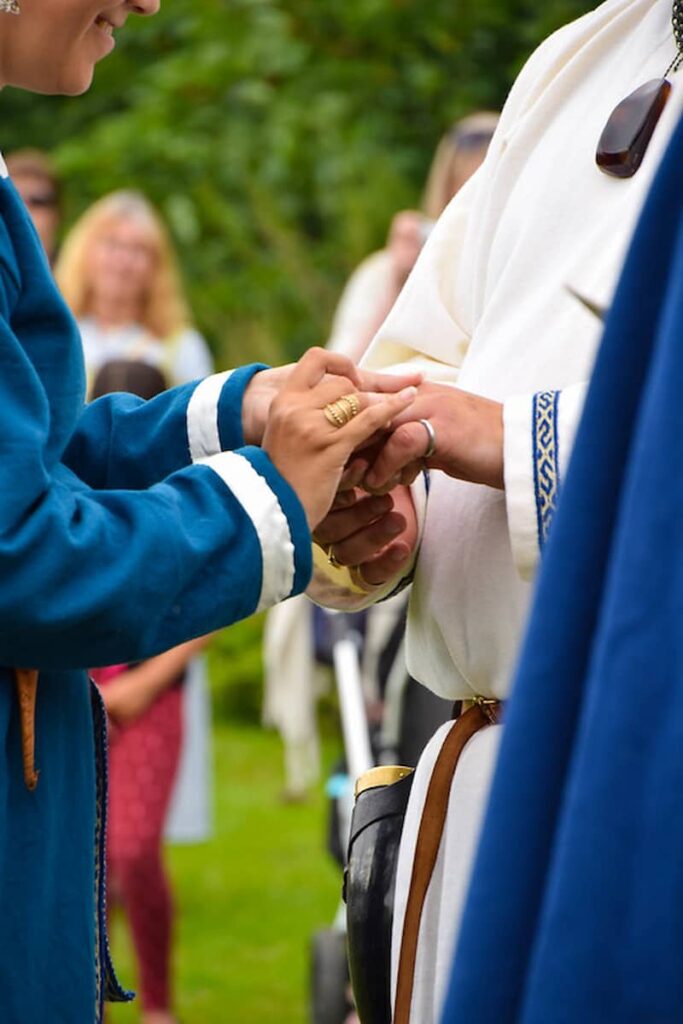
While these vows may seem pretty similar to some modern wedding vows, they were heartfelt and meaningful to Viking couples. The focus was on the commitment to love and honor each other for life, rather than on flowery language or grand gestures.
In addition to the vows, Viking weddings often included a handfasting ceremony, where the couple’s hands were bound together with a ribbon or cord to symbolize their union. This tradition is still popular in modern Pagan and Wiccan wedding ceremonies.
Overall, Viking wedding vows were a reflection of the practical and straightforward nature of Viking culture. While they may not have been as elaborate as modern wedding vows, they were just as meaningful and heartfelt.
Find out more about: What Language Did the Vikings Speak? (Ultimate Guide)
What is a Viking wedding called?
A Viking wedding, also known as a Norse wedding, was a traditional ceremony that united not only the bride and groom, but also their families. While we may not know the word used by Vikings in old Norse, weddings usually took place on a Friday, otherwise known as Frigg’s Day or Freya’s Day.
Freya was the Norse goddess of fertility, making it the most auspicious day of the week to hold a marriage. In addition, Viking weddings were usually held during the summer as this was easier for guests to travel to compared to heading through thick snow in winter.
The Viking wedding was a week-long celebration filled with feasting, music, and dancing. It was an opportunity for the bride and groom’s families to come together and form alliances.
What did Viking brides wear?
When it came to Viking weddings, brides didn’t necessarily wear white dresses like we see in modern weddings. Instead, they wore long flowing dresses of any color with ruffles. The color of the dress could be anything from blue to green to red, as long as it was a vibrant color.
One important aspect of what Vikings looked like in bridal attire was the headdress. Brides would wear a crown or wreath made of flowers or herbs, which was thought to symbolize fertility and new beginnings. The headdress would often be accompanied by a veil, which was meant to ward off evil spirits.
Another important aspect of Viking bridal attire was the jewelry. While the question of whether Vikings had piercings remains, Viking brides at least would wear a variety of jewelry, including necklaces, bracelets, and earrings, often made of silver or gold. These accessories were thought to be a symbol of wealth and status.
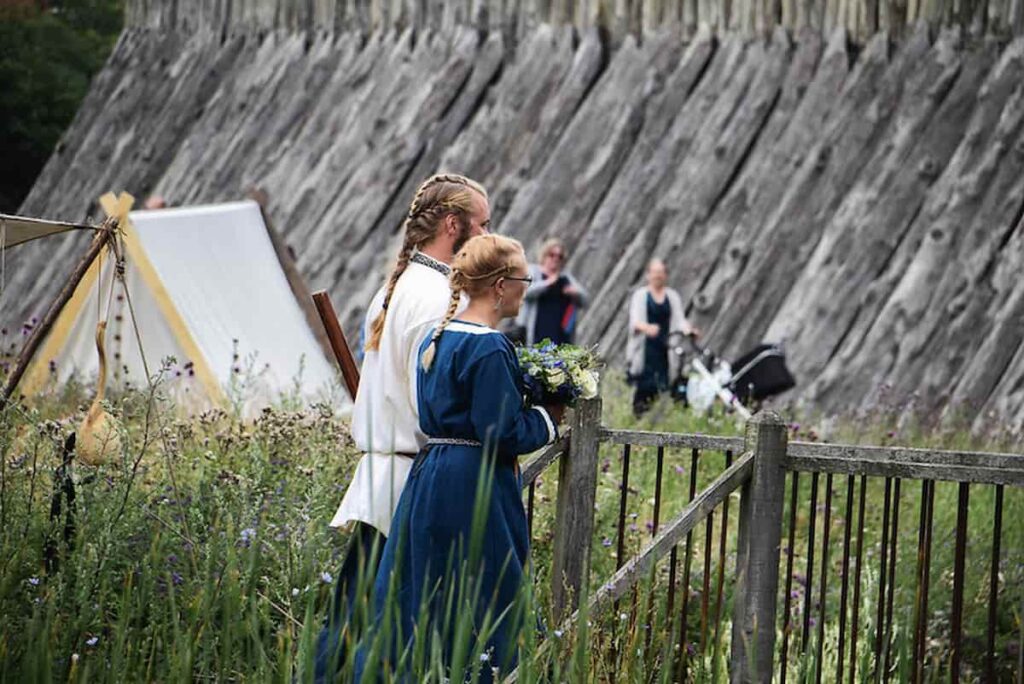
Finally, it’s worth noting that Viking brides often wore fur or woolen cloaks to keep warm during the winter months. These cloaks were often decorated with intricate embroidery or patterns, and were a symbol of the bride’s skill and craftsmanship.
Overall, Viking bridal attire was colorful, ornate, and full of symbolism. From the dress to the headdress to the jewelry, every aspect of the bride’s outfit was carefully chosen to represent fertility, new beginnings, and wealth.
You may also be interested in: Did Vikings Wear Makeup (And What Did It Look Like)?
What color did Viking brides wear?
When it comes to Viking weddings, brides had a lot of freedom when it came to their choice of dress color. Unlike modern weddings where white is the traditional color for the bride, Viking brides could wear any color they wanted. In fact, white was not a popular choice at all.
Traditionally, Viking brides wore long dresses in bright, bold colors such as red, blue, green, and yellow. These dresses were often decorated with intricate patterns and embroidery, and sometimes even had fur trim. The color red was particularly popular, as it was associated with love, passion, and fertility.
Interestingly, the Vikings didn’t make a big deal out of the bride’s dress. While it was important for the bride to look beautiful, the focus of the wedding was on the ceremony itself, rather than the clothing.
In fact, the Vikings cared more about the bride’s hair than her dress. Brides would often wear their hair in elaborate braids and adorn it with jewelry and flowers.
In summary, Viking brides had a lot of freedom when it came to their choice of dress color. They typically wore long dresses in bright, bold colors such as red, blue, green, and yellow, and often decorated with intricate patterns and embroidery.
While the bride’s dress was important, the focus of the wedding was on the ceremony itself, rather than the clothing.
You may also be interested in: Vegvisir Meaning: Origins of the Viking Compass Symbol
Who Officiates a Viking Wedding?
In Viking weddings, the officiant played a crucial role in the ceremony. Traditionally, Viking weddings were officiated by a Pagan priest or priestess, also known as a Gothi, Goði, or Gyðja. These individuals were responsible for leading the couple through various rituals and ceremonies, invoking the blessings of the gods and goddesses.
They also ensured that the ceremony was conducted in accordance with the couple’s wishes.
Today, many modern Viking weddings are still officiated by a Gothi, Goði, or Gyðja. These individuals are often well-versed in Norse mythology, Viking history, and Pagan rituals, and can help the couple create a ceremony that is both meaningful and authentic.
However, it’s important to note that not all Viking weddings are Pagan in nature. Some couples choose to incorporate Viking elements into a more traditional wedding ceremony, and may opt to have a friend or family member officiate the wedding instead.
Regardless of who officiates the ceremony, it’s important to remember that the focus of a Viking wedding is on the couple and their commitment to each other.
Whether you choose to have a Pagan priest or priestess, a friend, or a family member officiate your wedding, the most important thing is that the ceremony reflects your shared values and beliefs.
What is the Viking Symbol for Marriage?
When it comes to Viking weddings, the Valknut is the symbol that represents marriage. This symbol consists of three interlocked triangles that have been used for centuries as a wedding symbol. The Valknut has many benefits that make it an ideal choice for weddings, including its representation of strength and unity.
According to Viking mythology, the Valknut symbolizes the afterlife and the connection between the living and the dead. It is also believed to represent the three Norns, who were goddesses of fate and destiny.
The three interlocked triangles of the Valknut are said to represent the past, present, and future.
The Valknut was often included in the Viking wedding ceremony in various ways. For example, it may be included in the wedding invitations, on the wedding cake, or as a decoration at the wedding venue.
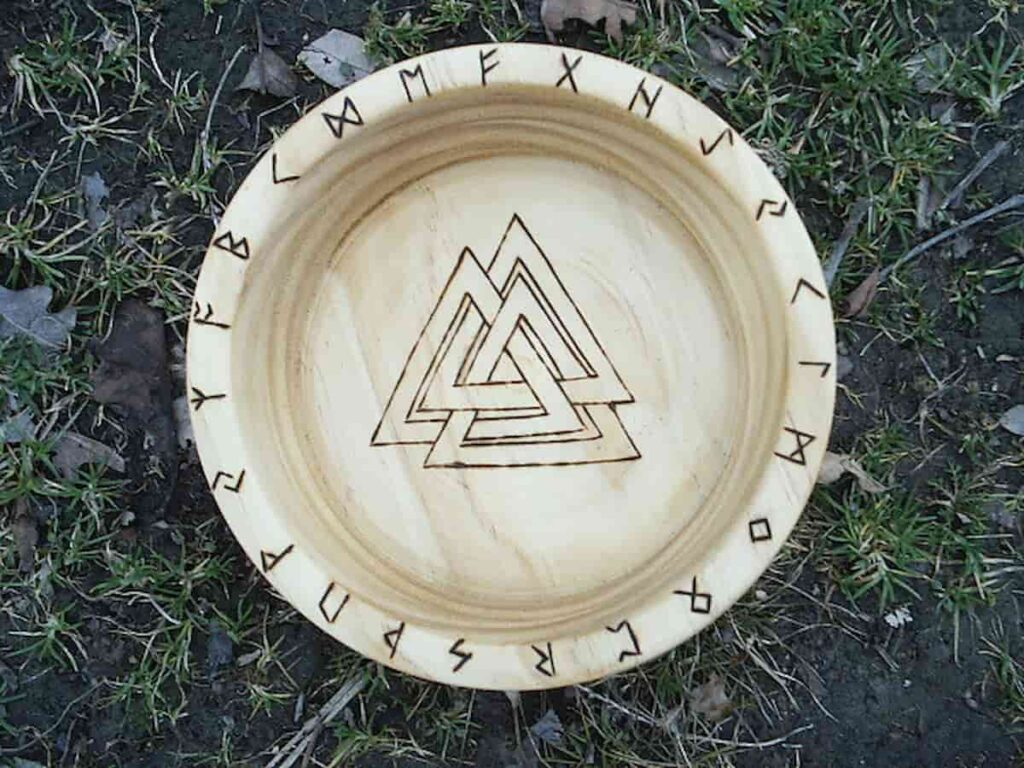
It may also be incorporated into the wedding rings or other jewelry worn by the bride and groom.
Overall, the Valknut is a powerful symbol that represents the strength and unity of a couple’s love and commitment. Its deep roots in Viking mythology make it a meaningful and timeless symbol for weddings today.
At What Age Did Vikings Marry?
According to historical records, Viking men and women were expected to marry before the age of 20. This was due to the fact that life expectancy during those times was roughly 50 years, with many Norse people failing to reach their 40s.
As a result, it was important for young people to marry and start families early in life.
However, it’s important to note that not all Vikings got married at such a young age. Some may have waited until their mid-20s or even later, especially if they were focused on other pursuits like raiding or trading.
It’s also worth mentioning that while marriages were often arranged, the consent of both parties was still important. Both the bride and groom had to agree to the marriage before it could take place.
Accordingly, the timing of a marriage depended on a variety of factors, including the individual’s personal goals and circumstances.
Were Viking marriages monogamous?
When it comes to Viking marriages, there is a common misconception that polygamy was the norm. However, this is not entirely accurate. While polygamy did exist among the Vikings, it was not widespread and only practiced by the wealthiest members of society.
Marriage among the Vikings was essentially a business contract between two families, and it served many purposes beyond just providing companionship and love. It was a way to establish alliances, secure property, and ensure the continuation of the family line.
In fact, the ideal form of marriage in Viking society was monogamy. While polygamy was allowed, it was not necessarily encouraged or seen as the norm. Most Vikings tied themselves to one person in marriage, and divorce was rare but possible.
It’s important to note that the concept of romantic love as the basis for marriage did not exist in Viking society. Courtship was not strictly necessary, and marriage was more about practical considerations than emotional ones.
As such, while polygamy did exist among the Vikings, it was not the norm, and monogamy was considered the ideal form of marriage. Marriage was seen as a practical arrangement rather than a romantic one, and it served many purposes beyond just providing companionship and love.
How did a Viking propose?
When it came to proposing, Vikings followed a strict set of customs and traditions. Proposals generally always came from the man in a Viking courtship, or his father. The male would contact the family of the girl they wished to marry, and negotiations would begin.
Once the negotiations were complete, the groom-to-be would present his intended bride with a gift, which could be anything from jewelry to livestock. This gift was known as a “mundr” and was considered a sign of the groom’s commitment to the marriage.
It was also customary for the bride-to-be to bring a dowry to the wedding, which was known as “heimanfylgja.” This dowry could include anything from land to household goods and was considered a sign of the bride’s worth.
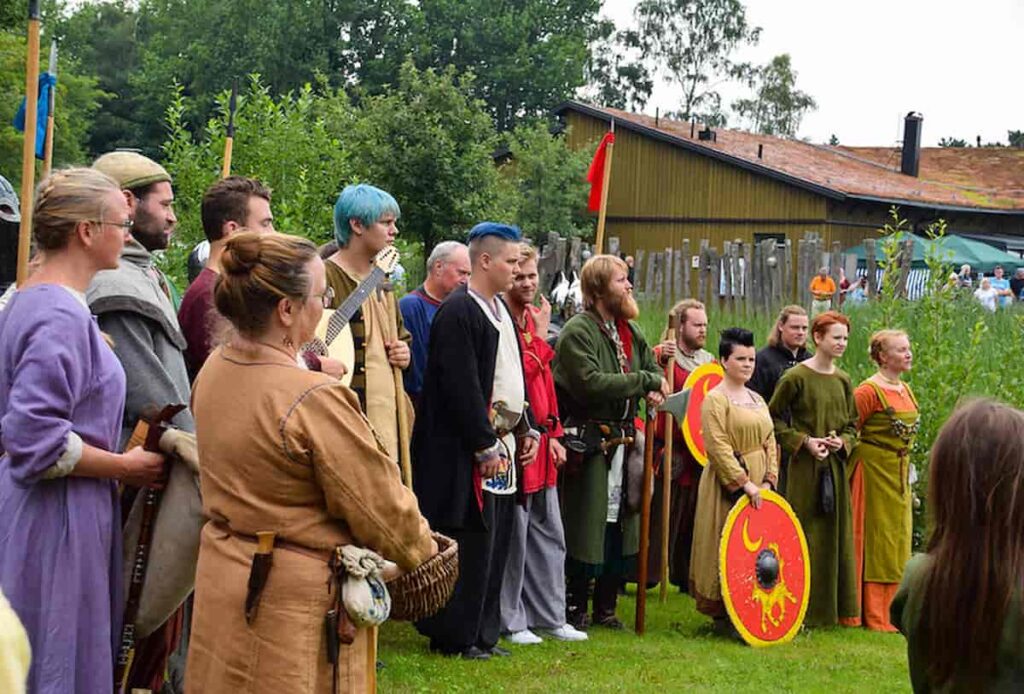
After the proposal and negotiations were complete, the wedding preparations would begin. Viking weddings were more of a business transaction, and love was not involved. The bride and groom exchanged finger rings and arm rings as wedding vows were spoken.
Overall, Viking proposals were a formal affair, with negotiations and gifts playing a crucial role in the process. While love may not have been the driving force behind Viking marriages, the customs and traditions surrounding Viking proposals and weddings were rich and meaningful.
Did Vikings give kittens to brides?
As a lover of all things feline, I was intrigued to learn about the legend that Vikings used to gift their new brides with kittens. According to the legend, this tradition was done to honor the goddess of love, Freyja, who was known for her love of cats. While there is no concrete evidence to support this legend, it is still a fascinating piece of Viking history.
Some sources claim that kittens were indeed given as wedding gifts, but there is no way to know for sure. Regardless of whether or not the legend is true, it is clear that cats played an important role in Viking culture.
Freyja was not only the goddess of love but also the goddess of luck, and it was believed that cats could bring good luck to their owners.
In fact, there are even stories of Vikings taking their cats with them on their voyages, as they believed that the cats could help steer the ship and protect them from evil spirits.
So whether or not Vikings actually gave kittens as wedding gifts, it is clear that cats were highly valued and respected in Viking culture.
